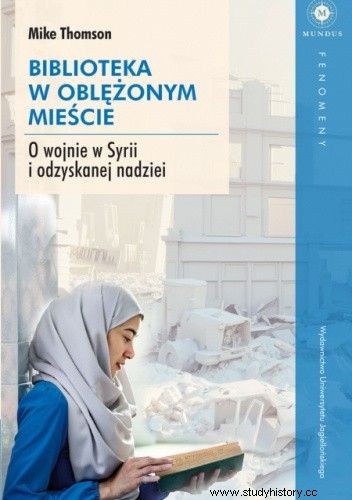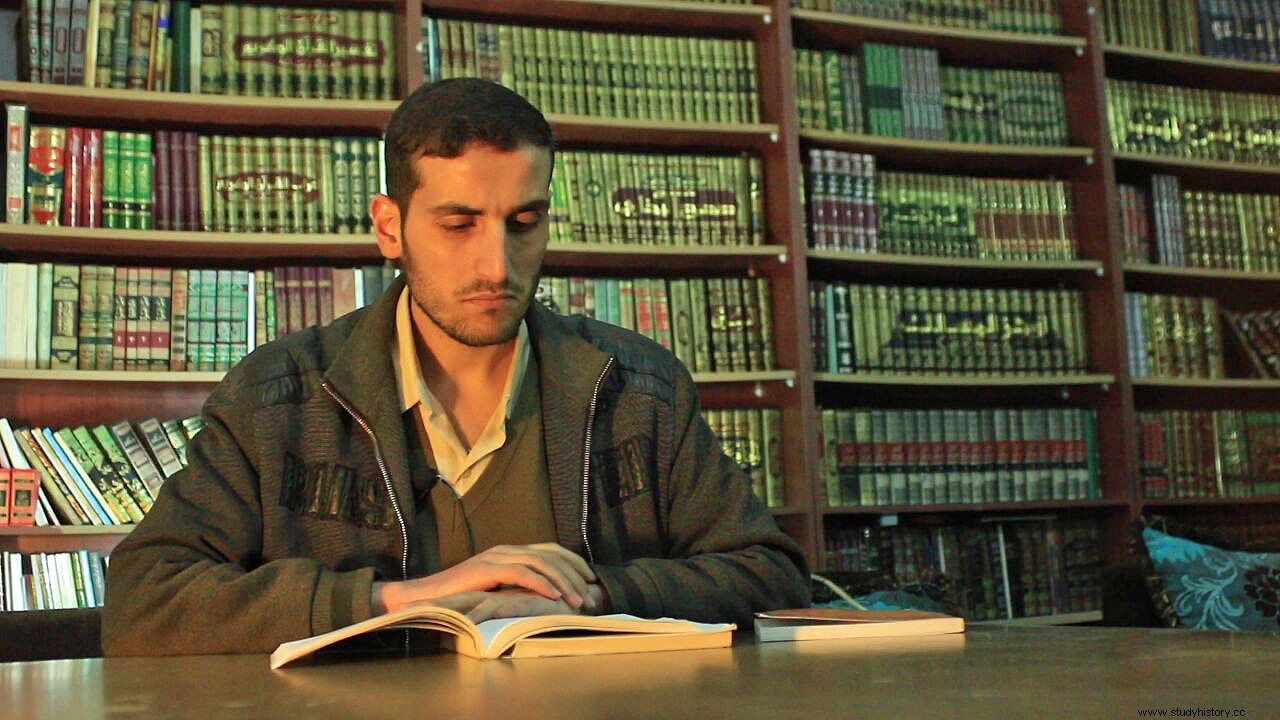Since the beginning of the war, the Syrian city of Darajja has been hailed by a hail of bombs and missiles. But there was a secret place deep under the rubble. The underground library was for the inhabitants a symbol of hope and faith in the value of culture. That's why they created it risking their lives ...
The siege ring was closing quickly. On the last day of 2012, a slight fog was hovering over Darajja, partially obscuring the war-torn areas outside the city. In the cool air, a few civilians walked briskly through the streets and listened for planes arriving. The scary sound that was suddenly heard was not, however, from heaven. It was from the fields that blew the earth-shattering rumble of engines and tracked vehicles.
The rumble grew, mixed with the shouts and screeching of military walkie-talkies. There was a whistle of missiles and a deafening thunder as they hit their target. Syrian authorities have launched another large-scale attack on Darajja. During the following weeks, regime forces continued to advance, threatening to seize control of the city. But despite the decisive numerical and technical advantage of the opponent, several hundred rebels persistently resisted (...).
"We were ordinary civilians"
During the initial period of the conflict, the rebel troops in Darajja belonged to many different groups allied with WAS. As Ratib Abu Fajiz said, they were "just young men who decided to fight to defend our city from the regime's attacks" . It was amazing, however, that with limited outside help, this group of only a few hundred stopped the march of a relatively strong Syrian army.
Nobody expected this not only because of the small number of fighters, but also because at this stage of the fighting, members of the rebel troops had no training behind them. Initially, they were also not completely consistent in terms of the alliances they made. With time, however, most of the fighters belonged to only two rebel groups:the Islamic Martyrs Brigade and the Islamic Ajnad al-Sham Union (Soldiers of Great Syria). These groups, in turn, allied themselves with wider coalitions - the Conquest Army and the Southern Front, supported by Western countries (...).

The text is an excerpt from Mike Thomson's book Library in a Besieged City. About the war in Syria and the regained hope, which has just been published by the Jagiellonian University Publishing House.
Many of Ratiba's comrades in arms were from Darajja, but some of the fighters came from Damascus and other parts of Syria. They didn't look like a regular army because they didn't wear uniforms. Firstly, because under siege they did not have the material needed to sew them. Second, uniform was not a priority for so many other urgent matters, such as getting food, taking care of the wounded, and most of all fighting against far more numerous and better armed enemy troops. Ratib explained that there was another good reason:
We were actually ordinary civilians, until recently we studied at the university. We didn't want to wear camouflage uniforms like soldiers in the Syrian army. Most of us hated the regime's forces and we really didn't want to look like soldiers under orders that has oppressed us for so long.
According to Ratib, the rebel forces in Darajji differed from similar units elsewhere in the country in terms of command and the form of relationship between recruits and officers:they were much less hierarchical. Many of the WAS leaders came from the same backgrounds as their subordinates, had similar jobs, and often lived in the same neighborhoods. The biggest difference between the rank and file soldiers and their commanders seemed to be that the latter had more responsibilities (...).
With tank rifles
In the early days, Ratib and his comrades waged a pulled war. They were not yet well trained or equipped to take more conventional action against regime forces. Ratib described the steps taken during the approach of the regime's land forces to the city:
We hid in abandoned buildings and made holes in the walls, or sat and waited for them to come within range of our rifles. We had to fight this way because we had very simple weapons. And they had tanks and all kinds of advanced weapons.
When there were no buildings for hiding places, the rebels set up trap mines or masked themselves in ditches they had dug. In this way, although they could not break the siege, they held back the further advance of government forces. Nevertheless, bombs, rockets and missiles have been falling on Darajja almost continuously since the end of 2013. Both sides were entrenched, but the front line was seldom clearly defined. Troops on one side moved forward and occupied several buildings or even an entire street or strip of land, but then the other side counterattacked and pushed the enemy back to their previous positions.

Location of Darajja on the map of Syria
In the city, as Ratib said, the front line sometimes ran along a single street . On both sides of the street, snipers, whether from the regime or rebels, hid from the eyes of the enemy. (...) Sometimes in the open, both sides built barricades of earth and sandbags to protect themselves from the enemy.
The frontline in the fields around Darajja, however, was quite different and often difficult to decipher. Soldiers, both rebel and government, often took up positions in innocent-looking farm buildings or lay disguised in shallow ditches dug in the fields. The forces of both sides were separated by wide strands of no-man's-land, covered with fields of ripe corn swaying slightly in the wind. However, these crops were under the crossfire of snipers and attempting to harvest them would have meant certain death.
Hungry minds
Despite the slow advance and retreats, government forces conducted rather static activities. (...) In the summer of 2013, one of the first buildings razed to the ground in the center of Darajja was the legendary Kuszak ice cream shop, and shortly thereafter the once lively Central Toaster, just a few houses away, collapsed in ruins. The owners of Kuszak escaped with their lives. The family that ran Central Toaster weren't so lucky.
From the very beginning of the siege, Syrian government forces did not allow international or domestic humanitarian convoys into the city. Initially, Darajja somehow managed thanks to a strong agricultural tradition that made the area a granary of Damascus. As regime forces advanced, harvesting the crops, however, became more and more difficult as the troops took over more farmland. If the villagers managed to grow something, they often could not collect it due to the constant presence of snipers. (...) Soon, hunger simply became an ever-present part of everyday life. Food was smuggled through enemy lines for a while, but the practice became more and more dangerous.

Young people in Darajji risked their lives every day to save books of all kinds, hoping that with them they would help build a better tomorrow.
There were at least brief ceasefires during which no bombs or missiles fell on the city. Although this did not mean that all snipers put away their rifles, it did give the townspeople a chance to harvest crops or get food, and it stopped the merciless massacre for a while.
It was during one of these precious periods of peace that a group of young men, almost entirely made up of former students, began to consider more constructive ways of spending their time. (...) How could they both keep their minds fit and act on behalf of a besieged and battered community?
(...) These educated young people, most of whom did not take part in the fights at that time, did not want to sit and watch the growing vegetables, protecting themselves from bullets. They had tons of ideas on how to make life more meaningful. (...) The idea of creating a book composition that would allow them to be protected against bombing and destruction was received with the greatest enthusiasm.
Save what you can
All these former students worked in different fields, but they had one thing in common - a love of books. Whether it was chemistry or economics, poetry or physics, handbooks or fiction - it didn't matter. (...) The devastating fire of the old, highly valued city library was a severe blow to the entire community. So a group of young people decided to set up a new, even better institution (...).
Young people in Darajji risked their lives every day to save books of all kinds, hoping that they would help to build a better tomorrow. (...) Many of them participated in the creation of the secret city library, including 14-year-old Amjad, self-proclaimed chief librarian, Anas Habib, dynamic and hardworking, former civil engineering student, Abdul Basit, former student of business and economics, volunteer at the hospital, Ajham As-Sakka, avid reader, former student of dentistry, Homam at-Tun, former student of pharmacy, Sara Matar, who was to become a brave and devoted teacher, Ratib Abu Fajiz, a rebel fighter who not only took the loaned items to the front but also led in the trenches a book discussion club (…).

The text is an excerpt from Mike Thomson's book Library in a Besieged City. About the war in Syria and the regained hope, which has just been published by the Jagiellonian University Publishing House.
The group members received information that many valuable books remained in some of the bombed-out houses. Rain, sun and wind quickly destroyed them, because in the ruined buildings where they were located, there were no windows, walls or even roofs. According to the data provided to the group, some of the books were kept in small private libraries about which many people in Darajji were unaware before the war.
Whole weeks spent the group members searching for information. They asked all their friends about the buildings where the endangered books might have been located. Then, with a long list of possible addresses in hand, the young people formed volunteer search teams. They decided to save as many books as they could find, for the sake of the absentee owners and for the sake of the community as a whole.
Source:
The text is an excerpt from Mike Thomson's book Library in a besieged city. On the war in Syria and hope regained , which has just been released by the Publishing House of the Jagiellonian University.
